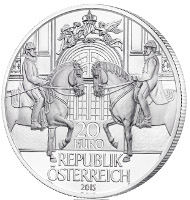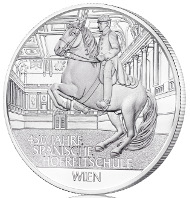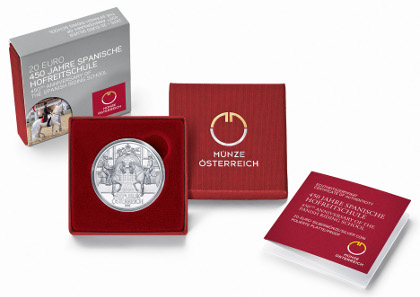February 19, 2015 – This year the world famous and cultural icon of the horse world is celebrating the 450th anniversary of its founding. The Spanish Riding School, headquartered in Vienna and located in the Imperial Palace complex in the heart of the city, was founded during the Renaissance period. The Riding School is the oldest institution of its kind in the world.
The obverse of the coin depicts a pair of Lipizzaner stallions and their riders performing a Pas de deux, a traditional highlight of their performance, which requires very high levels of concentration and coordination. These elements are the core part of the design. In the background a portion of the winter riding school of the Imperial Palace complex is viewed. Fine details can be seen of the classic baroque building designed by Joseph Emanuel Fischer von Erlach and built between 1729 and 1735. One of many huge windows, located around the performance hall which bath the hall in bright sun is seen in the background. Above the window, sculpted in wood and plaster, is the Imperial Crown of the Austro-Hungarian Empire, easily recognized because of the rounded double top as well as the double-headed eagle looking east and west, holding the ribbons in its beak.
Austria / 20 euros / 900 fine silver / 34 mm / Design: Thomas Pesendorfer and Herbert Waehner / Mintage: 50.000.
The very formal and classically designed style of the obverse is a fitting reflection of the Imperial origins for this breed of horses and the classic riding school. The design and engraving are the work of the mint’s master engraver, Thomas Pesendorfer. The face value of 20 euros, as well as the country of issue “Republik Oesterreich” Republic of Austria and the year of issue are also located on this side of the coin.
The reverse depicts a stallion and rider executing a Levade, one of the school’s equestrian inventions, in which the stallion puts its entire weight on its hind legs and raises its front legs no more than 45 degrees. Also visible is the facetted ceiling of the very elaborate performance hall as well as the many columns around the second level of the hall with its elaborate railings. The words “450 Jahre Spanische Hofreitschule” or 450 years of the Spanish Riding School are superimposed over the earth floor of the performing hall. The city of “Wien” or Vienna is visible just below this floor. The reverse was designed and engraved by mint engraver Herbert Waehner.
One of Vienna’s most esteemed institutions, this world famous riding school is located in the Michaelertrakt of Vienna’s Hofburg Palace. It is a magnet for visitors from all over the world. The iconic whitish-grey Lipizzaner stallions and their riders perform in 70 classical performances every year and regularly tour numerous European cities such Paris, London, Berlin, Brussels, to name just a few.
The Lipizzaner breed was developed during the Renaissance period when classical equitation was back in favor. The Hapsburg Imperial family recognized the need for agile light horses by the military. They crossed a Spanish horse, which had Arabian and Berber stallion origins with Iberian mares, at a time when the Hapsburgs controlled Austria as well as Spain. The Lipizzaner’s are born with dark colored coats – variations of brownish black. They become light grey by the time the horses reach the ages of between 6 and 10 years. Their trademark large eyes and small perky ears give them an endearing face. The Lipizzaner is considered a rather “small” horse but the powerful strength of the stallions is very evident in their well-defined muscles and tendons of their hindquarters, shoulders and legs.
There are some 70 Lipizzaner stallions in the riding school and 20 riders, of which only 2 have the “chief rider” designation. Each year only some 300,000 visitors are fortunate to secure the highly coveted tickets to the performances.
The goal of the Riding School remains today as it was in the beginning – the place where classical horsemanship is bred through the art and dedication to teach and perform classic dressage.
The “Lipizzaner” coin is 900 fine silver, has a face value of 20 euros (legal tender in Austria), contains 18 grams of pure silver and has a diameter of 34 mm. The maximum mintage of this special uncirculated coin is 50,000 pieces. Each coin is encapsulated and comes in box with a sleeve and an individually numbered certificate of authenticity.
More information about the coin you may find on the website of the Austrian Mint.
Here you can visit the Spanish Riding School online.
Or you can watch the famous horses on Youtube.







